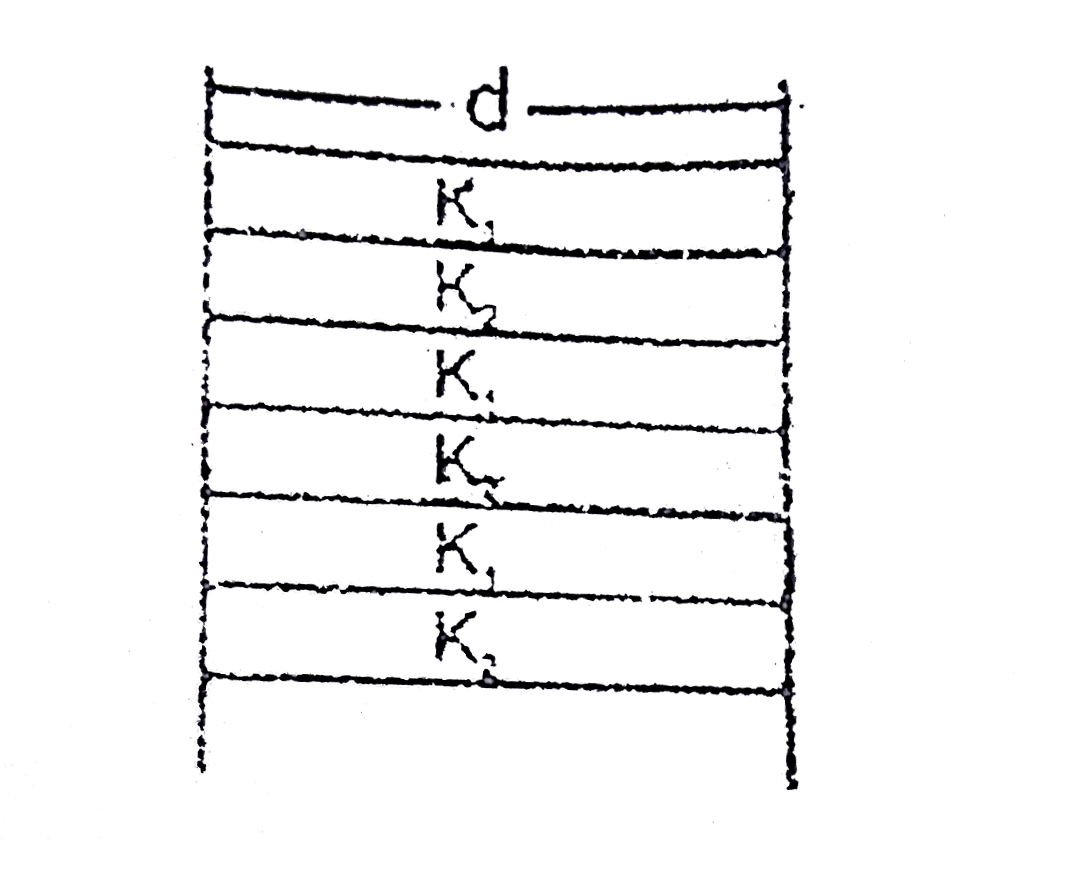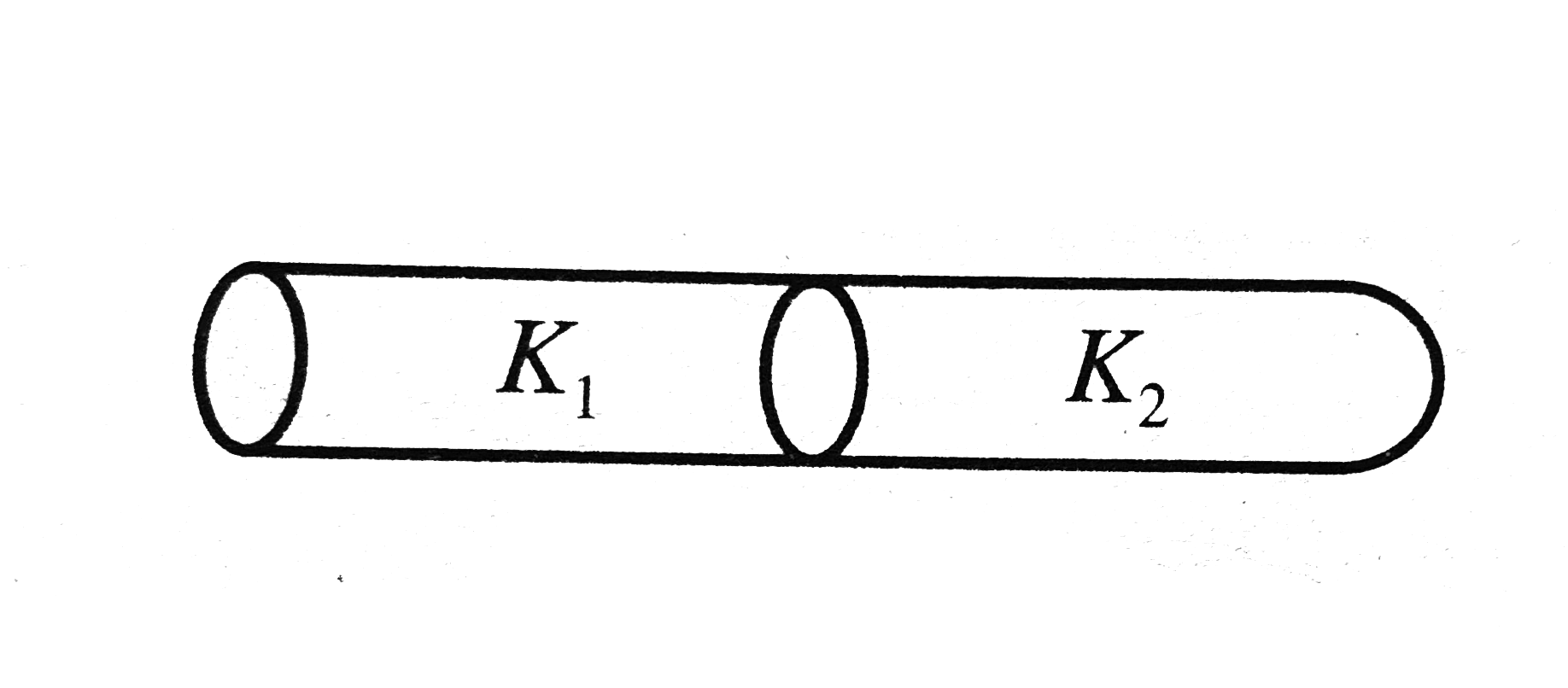Two rods of length d1 and d2 and coefficients of thermal conductivites K1 and K2 are kept touching each other. Both have the same area of cross-section. The equivalent thermal conductivity.
K1+K2
K1d1+K2d2
K2d1+K1d2d1+d2
d1+d2d1K1+d2K2
To find the equivalent thermal conductivity of two rods in contact, we can follow these steps:
1. Identify the Parameters:
- Let the lengths of the two rods be d1 and d2.
- Let the coefficients of thermal conductivity be K1 and K2.
- Both rods have the same cross-sectional area A.
2. Understand the Concept of Thermal Resistance:
- The thermal resistance R for a rod can be expressed as:
R=LKA
- Where L is the length of the rod, K is the thermal conductivity, and A is the cross-sectional area.
3. Calculate the Individual Thermal Resistances:
- For rod 1:
R1=d1K1A
- For rod 2:
R2=d2K2A
4. Determine the Total Thermal Resistance:
- Since the rods are in series, the total thermal resistance Rtotal is the sum of the individual resistances:
Rtotal=R1+R2=d1K1A+d2K2A
5. Express the Total Resistance in Terms of Equivalent Conductivity:
- The equivalent thermal resistance Req for a single rod of length d1+d2 and equivalent thermal conductivity Keq can be expressed as:
Req=d1+d2KeqA
6. Set the Total Resistances Equal:
- Since both expressions represent the total thermal resistance, we can set them equal to each other:
d1+d2KeqA=d1K1A+d2K2A
7. Cancel the Area A:
- Since A is the same for both rods, it cancels out:
d1+d2Keq=d1K1+d2K2
8. Rearrange to Solve for Keq:
- Rearranging gives:
Keq=(d1+d2)(d1K1+d2K2)
Final Result:
The equivalent thermal conductivity Keq of the two rods is given by:
Keq=(d1+d2)(d1K1+d2K2)
- Let the lengths of the two rods be d1 and d2.
- Let the coefficients of thermal conductivity be K1 and K2.
- Both rods have the same cross-sectional area A.
- The thermal resistance R for a rod can be expressed as:
R=LKA
- Where L is the length of the rod, K is the thermal conductivity, and A is the cross-sectional area.
- For rod 1:
R1=d1K1A
- For rod 2:
R2=d2K2A
- Since the rods are in series, the total thermal resistance Rtotal is the sum of the individual resistances:
Rtotal=R1+R2=d1K1A+d2K2A
- The equivalent thermal resistance Req for a single rod of length d1+d2 and equivalent thermal conductivity Keq can be expressed as:
Req=d1+d2KeqA
- Since both expressions represent the total thermal resistance, we can set them equal to each other:
d1+d2KeqA=d1K1A+d2K2A
- Since A is the same for both rods, it cancels out:
d1+d2Keq=d1K1+d2K2
- Rearranging gives:
Keq=(d1+d2)(d1K1+d2K2)
The equivalent thermal conductivity Keq of the two rods is given by:
Keq=(d1+d2)(d1K1+d2K2)
Topper's Solved these Questions
Similar Questions
Define coefficient of thermal conductivity. Two metal slabs of same area of cross-section, thickness d1 and d2 having thermal conductivities K1 and K2 respectively are kept in contact. Deduce expression for equivalent thermal conductivity.
View SolutionTwo identical metal wires of thermal conductivities K1 and K2 respectively are connected in series. The effective thermal conductivity of the combination is :
View Solution
Knowledge Check
- Question 1 - Select One
A wall consists of alternating blocks withlength 'd' and coefficient of thermal conductivity k1 and k2. The cross sectional area of the blocks are the same. The equivalent coefficient of thermal conductivity of the wall between left and right is:-
 AK1+K22B2K1+K2K1+K2CK1+K23D3K1+K2K1+K2
AK1+K22B2K1+K2K1+K2CK1+K23D3K1+K2K1+K2 - Question 2 - Select One
A wall consists of alternating blocks withlength 'd' and coefficient of thermal conductivity k1 and k2. The cross sectional area of the blocks are the same. The equivalent coefficient of thermal conductivity of the wall between left and right is:-
 AK1+K2B(K1+K2)2CK1+K2K1+K2D2K1+K2K1+K2
AK1+K2B(K1+K2)2CK1+K2K1+K2D2K1+K2K1+K2 - Question 3 - Select One
A wall consists of alternating blocks withlength 'd' and coefficient of thermal conductivity k1 and k2. The cross sectional area of the blocks are the same. The equivalent coefficient of thermal conductivity of the wall between left and right is:-
 AK1+K2B(K1+K2)2CK1K2K1+K2D2K1+K2K1+K2
AK1+K2B(K1+K2)2CK1K2K1+K2D2K1+K2K1+K2
A composite slab is prepared by pasting two plates of thickness L1 and L2 and thermal conductivites K1 and K2 . The slab have equal cross-sectional area. Find the equivalent conductivity of the composite slab.
View SolutionTwo rods of the same area of cross-section, but of length l1 and l2 and conductivites K1 and K2 are joined in series. Show that the combination is equivalent of a material of conductivity K=l1+l2(l1K2)+(l2K2)
View SolutionTwo rods of length l and 2l thermal conductivities 2K and K are connected end to end. If cross sectional areas of two rods are eual, then equivalent thermal conductivity of the system is .
View SolutionIf two metallic plates of equal thickness and thermal conductivities K1 and K2 are put together face to face and a common plate is constructed, then the equivalent thermal conductivity of this plate will be
 View Solution
View Solution Statement I: Two solid cylindrical rods of identical size and different thermal conductivity K1 and K2 are connected in series. Then the equivalent thermal conductivity of two rods system is less than that value of thermal conductivity of either rod.
Statement I: Two solid cylindrical rods of identical size and different thermal conductivity K1 and K2 are connected in series. Then the equivalent thermal conductivity of two rods system is less than that value of thermal conductivity of either rod.
Statement II: For two cylindrical rods of identical size and different thermal conductivity K1 and K2 connected in series, the equivalent thermal conductivity K is given by 2K=1K1+1K2View Solution

